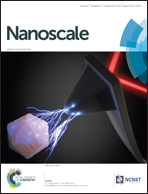Two-dimensional molybdenum disulphide nanosheet-covered metal nanoparticle array as a floating gate in multi-functional flash memories†
Abstract
Semiconducting two-dimensional materials appear to be excellent candidates for non-volatile memory applications. However, the limited controllability of charge trapping behaviors and the lack of multi-bit storage studies in two-dimensional based memory devices require further improvement for realistic applications. Here, we report a flash memory consisting of metal NPs–molybdenum disulphide (MoS2) as a floating gate by introducing a metal nanoparticle (NP) (Ag, Au, Pt) monolayer underneath the MoS2 nanosheets. Controlled charge trapping and long data retention have been achieved in a metal (Ag, Au, Pt) NPs–MoS2 floating gate flash memory. This controlled charge trapping is hypothesized to be attributed to band bending and a built-in electric field ξbi between the interface of the metal NPs and MoS2. The metal NPs–MoS2 floating gate flash memories were further proven to be multi-bit memory storage devices possessing a 3-bit storage capability and a good retention capability up to 104 s. We anticipate that these findings would provide scientific insight for the development of novel memory devices utilizing an atomically thin two-dimensional lattice structure.



 Please wait while we load your content...
Please wait while we load your content...